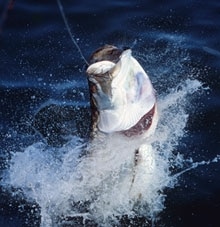
| Big tarpon can be caught along the Texas coast from June through October. Photo: DavidJSams.com |
Successful fishermen are nothing if not resourceful. When a bait, lure or tactic isn’t working, the pros can figure out why and adjust. But what happens when an entire fishery fairly ceases to exist? The answer is the same: change. And that’s where this tale of Texas tarpon fishing begins.
“Reds and trout were our main target fish,” explained guide Joe Trimble of Galveston, Texas. “But we had a hard freeze in 1989 that killed thousands of trout and reds. The first summer after the freeze we were having such a tough time finding trout and reds that we decided to move out in the surf and hunt for tarpon. By 1990, we realized that the potential for catching them from about June through October was worth a shot.”
Trimble’s words have proven to be an understatement. Tarpon fishing along the Texas Gulf coast has produced some eye-opening catches over the years, including a state record 210-pounder caught on conventional tackle, and a silver king caught last August on a fly rod with an estimated weight of 200 pounds, just to name two.
The record fish was caught on November 13, 1973, by Houston angler Tom Gibson, Jr., a world-class tarpon angler. He set that mark while fishing along the south Texas coast out of South Padre Island. Coincidentally, Gibson was fishing the stretch of water where, in 1999, angler Kevin London caught and released a tarpon with an estimated weight of 214 pounds. That huge tarpon was seven feet, eight inches long – six inches longer than the state record. London was fishing from the beach but released the big fish because he didn’t have a tarpon tag. In Texas a $30 tag is required in addition to a fishing license to take a tarpon that is 80 inches or greater in length. Only one tag can be used per license year.
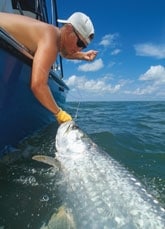
| |The best fishing for big tarpon occurs in and around baitfish schools. Pogies are a preferred food source. Photo: DavidJSams.com|
The aforementioned fly-caught tarpon fell for a deceiver worked by full-time Port O’Connor fly-fishing guide Captain Scott Graham. Measured and released, the tarpon taped seven feet, three inches long with a 43-inch girth. It was estimated at 200 pounds.
If that tarpon did indeed weigh around 200 pounds, that would have put it in the ranks of one of the heaviest ever caught on a fly rod. The IGFA world record for tarpon on the fly is 202 pounds caught by James Holland in 2001 off Cassahowitza, Florida. Holland caught the fish on 20-pound tippet. Graham used 40-pound-class tippet and battled that particular silver king for an hour and 20 minutes.
Since 1989, Trimble says that they have caught six tarpon with estimated weights over 200 pounds. The heaviest that he’s aware of weighed 258 pounds. That fish was caught and released. Days with virtually nonstop tarpon action are nothing new. One boat in the area hooked and landed 11 tarpon in a single day, and the best one-day tally for jumped tarpon stands at 23.
Tarpon Water
The most reliable way to locate and catch Texas tarpon is to have a boat that’s capable of making some long runs in seas that can be pretty rough at times. The tarpon bite is good just about anywhere along the Texas coast from Sabine Pass on the border of Texas and Louisiana, to the Port Isabel jetties on the border of Texas and Mexico. Port O’Connor, located on the middle Texas coast, was probably the number-one area to catch big tarpon last summer. But over the years it seems that the hot bite can occur all along the Texas coast.
Possibly the most famous and successful tarpon fishermen along the Texas coast are Trimble, James Plaag, Darrell Skillern and Dana Bailey – owners and operators of Silver King Adventures located in Galveston, Texas.
| How Big’s That Tarpon? In the early 1900s, William H. Wood, the pioneer of tarpon fishing, developed a formula for estimating the weight of tarpon in pounds. Its girth (squared) times its length – each measured in inches – divided by 800. It’s a fairly accurate formula that gives the approximate weight of almost every type of fish, no matter what shape or size.Bob Colura, a retired Texas Parks and Wildlife marine scientist, used this formula to calculate the weight of an estimated 214-pound tarpon caught in the South Padre Island, Texas, surf late in July 1999. That tarpon was estimated to be between 40 and 50 years old. – Robert Sloan |
“The earliest we’ve ever caught a tarpon was June 6, when the beachfront water temperature was about 75 degrees,” says Trimble. “The latest is October 15, when the water temperature had dropped down to 72 degrees.”
“We usually run for tarpon out of the Galveston jetties, and head east to the Sabine jetties,” says Trimble. “That’s about 38 miles of water. If we’ve got good green water, we’ll run just off the third sandbar, about 100 yards off the beach. But most of the time we’ll find the best water anywhere from a mile to nine miles offshore. The best water depths can range from 20 to 60 feet deep. If the water is sandy up close, I’ll move on out until I find water that’s green and semi-clear. That’s where the baitfish will most often be found. Where we find big schools of baitfish, there’s a good chance tarpon will be nearby.”
During the summer months tarpon will be feeding heavily on pogies, (a.k.a. menhaden). From about June until the end of October there will be huge rafts of pogies on the surface. At times you can see schools of tarpon feeding on them. That’s when you’ll do best by casting into the pogies or by bump-trolling baits over and around them. Tarpon can also be found feeding on rain minnows, shad and even silver-dollar-sized crabs at times.
When bump-trolling it’s usually best to use a bow-mounted trolling motor. This allows for more room in the stern for tending rods. However, in choppy seas the bow may continually pop the trolling motor prop out of the water and spook the fish.
Fishing dead baits, specifically pogies, is a tactic that has connected many anglers with tarpon. But it’s also a way to hook up with sharks, jacks and the occasional king mackerel. A wind-on leader is recommended in most situations when fishing dead baits or lures. When using fresh-dead baits like shad or pogies, rig them on 14/0 to 16/0 circle hooks without weights. They can be fished with or without a float. One tactic that works well is to use a balloon to keep a dead or live bait suspended at about six to eight feet deep. Blow up a balloon to about the size of a softball. Attach it to the line with the same knot used to seal the balloon. When a fish is on you can reel the balloon through the guides – it will pop when it hits the tip top – and onto the reel.
Most professional tarpon anglers will fish two to four rods off the stern with live or dead baits. You can rig a pogy by running the hook under the jaw or in the opening on top of the head between the eyes. During the summer months sharks can be such a nuisance that you can’t put a bait in the water without getting snipped off. If you think tarpon are in an area with sharks either keep rigging baits and deal with them or go with lures.
Shark-Free Fishing
“Over the years we’ve become more lure-oriented when it comes to hooking up with tarpon,” says Trimble. “Dead baits, or even live baits attract too many sharks. Because of that we’ve found that using an assortment of lures is best.”
| Trip Planner SILVER KING ADVENTURES Galveston, Texas Capt. James Trimble (281) 798-7199 Capt. James Plaag (409) 935-7242 www.silverkingadventures.comTARPON ADVENTURES Galveston, Texas Capt. Jim Leavelle (713) 515-8907 www.tarponadventures.comFLYFISHING Port O’Connor, Texas Capt. Scott Graham (512) 947-7145 www.flyfishingtexas.com Capt. Tom Horbey (361) 983-2263 www.captaintomhorbey.comSOUTH PADRE ISLAND, TEXAS Capt. Eric Glass (956) 761-2878 www.captainericglass.com |
The most popular and successful tarpon lures along the Texas coast are Coon Pops and slow-sinking MirrOlures. Coon Pops are best for bump-trolling. MirrOlures are best for casting to surface-rolling tarpon that feed on baitfish. Coon Pop lures have been around for a number of years and originally developed in Venice, Louisiana. They are not much to look at. In fact, the first time I tied one on I had serious doubts about its ability to catch tarpon. However, at the end of that day two of us had used them to catch seven tarpon. The heaviest was a 180-pounder that hit a Coon Pop at the end of my line. All doubts were erased.
The Coon Pop consists of a two-ounce leadhead jig that’s attached to a 16/0 circle hook. A wire is used to connect a six-inch curl-tail grub. These jigs are deadly on tarpon when cast or trolled. The chartreuse-colored Coon Pops seem to produce more tarpon than other color combinations, but pink, red and tiger-striped jigs will work as well. Captain Jim Leavelle, a veteran tarpon angler based out of Galveston, says that he likes to troll two to three Coon Pops off the stern, while anglers stand ready to cast with MirrOlures.
“My favorite MirrOlure for tarpon is the 77 series deep runner,” says Leavelle. “The best colors will be a red head with a yellow body. Another good color combination is chartreuse and gold. When casting lures I’ll try to get ahead of the tarpon and get my anglers to cast several feet ahead of a target fish.”
Bump-trolling lures is a good way to fish various levels of water. One tactic is to fish two Coon Pops and two slow-sinking MirrOlures. The MirrOlures will fish higher in the water column than the Coon Pops, and they have a lot more movement and flash. At times tarpon will jump on the flash of a plug. On other days they opt for the fast-sinking Coon Pop jigs with the waggling soft-plastic tails.
Using your outboard motor to bump-troll is taboo. In most situations you’ll be fishing in 20 to 35 feet of water. Tarpon are easily spooked at those depths. The best thing to do is to use your outboard to get as close as possible to a school of tarpon, then work in close with the trolling motor.
School Supplies
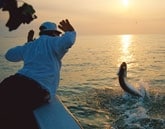
| |
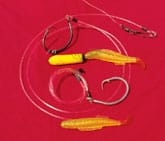
| |
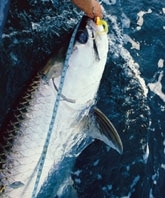
| |
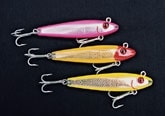
| |From top to bottom: Battling tarpon on the Gulf Coast (Photo: Dusan Smetana); Coon Pop lures, hooks and leaders; Measuring the length and girth of a tarpon provides a pretty good idea of its weight (Photo: Robert Sloan); Slow-sinking MirrOlures are preferred for casting to surface tarpon. Photo: DavidJSams.com|
To successfully fish for and catch Texas tarpon you’ll need both casting and trolling rods. Trimble uses a seven-foot, 20- to 30-pound-class rod for casting. The trolling rods are seven feet long, and 20- to 40-pound-class. The trolling rods are matched with Shimano TLD 15 reels spooled with 40-pound-test line. The casting rods are seated with Shimano Calcutta 700TE reels and spooled with either 30- or 40-pound-test monofilament line. Trolling rods perform double duty and are also used for drifting live or dead baits.
“Both the casting and trolling rods are rigged with wind-on leaders,” says Trimble. “I use a Power Pro 80- to 150-pound-test leader that’s roughly 25 feet long. I tie the leader to the line with an Albright or blood knot, and a uni-knot connects the leader to the lure. Sometimes I’ll use a four-foot monofilament leader that’s connected to the main line with a Sampo swivel.”
When tarpon are moving on the surface at a fast pace they are not feeding. Conversely, when you see them slow-rolling on the surface they are almost always feeding. When a school of tarpon is located always mark the spot on your GPS. It’s possible to fish the same school for three to five days.
“I’ve seen a school of tarpon that stretched as far as I could see,” says Tremble. “But more often than not most pods of tarpon will be holding 100 to 150 fish.”
Those big schools of tarpon will usually be feeding on pogies, and sometimes they will be holding close to the food source for days at a time. Once you know their general location you can pretty much use that same area as a starting point for days at a time.
That was the case last August when Graham located a school of big tarpon off Pass Cavallo, located a few miles west of the Port O’Connor jetties, on the middle Texas coast.
“I had seen rolling schools of tarpon outside the pass for several days,” says Graham. “It was just a matter of getting out there and finding them.”
| Tale of the Tag Biologists at the Texas Parks & Wildlife Department’s (TPWD) Perry R. Bass Marine Fisheries Research Station in Palacios, along with other marine scientists at Texas A&M University at Galveston and the Universidad Technologico de Victoria in Tamaulipas, Mexico, are studying the life history, ecology and genetics of tarpon. Biologists, guides and anglers around the world have been cooperating in the study, pulling scales for DNA analysis and tagging released fish since the 1990s. “The objective of this program is to define the stock of tarpon on the Texas coast,” said retired TPWD marine scientist Bob Colura. “We hope to determine if Texas tarpon live only in Texas waters or migrate and, if so, where. Tarpon have been found up and down the Texas coast for many years. The fish is increasingly popular among sport fishermen in Texas.”Researchers also hope to identify those tarpon haunts in Texas. The study has confirmed that some newly spawned fish enter the estuaries in Texas but there is no evidence that the young fish survive the winter, according to Colura, who noted the fish do not appear again in TPWD coastal fisheries samples for up to three years.Those interested in the program can contact Britt Bumguardner at the Perry R. Bass Marine Fisheries Research Station, HC 02 Box 385, Palacios, Texas 774654 or call TPWD at (361) 972-5483. – Robert Sloan |









